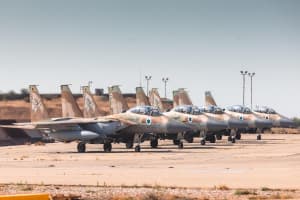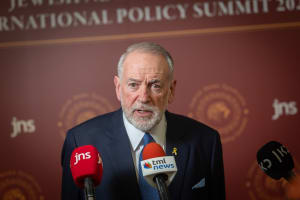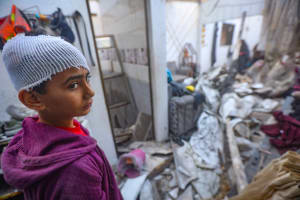US considers civilian nuclear program without enrichment as Iran fortifies nuclear sites
Secretary Rubio reaffirms that Iran cannot have nuclear weapons, but says ‘military action could trigger broader conflict’

New commercial satellite imagery revealed that Iran is constructing a large security perimeter around Mt. Kolang Gaz La, located south of the Natanz enrichment complex.
On Wednesday, a report released from the Institute for Science and International Security in Washington claimed that Iran is building a new, fortified tunnel complex south of the Natanz uranium enrichment facility. The development has raised concerns that the Islamic Republic is preparing for a potential attack on its nuclear facilities and may be planning to relocate at least part of its uranium enrichment operations to the site.
NEW SATELLITE IMAGERY shows Iran is constructing a new, large security perimeter around the base of Mt. Kolang Gaz La, an area housing a new, large tunnel complex, and a smaller one dating to 2007, located south of the Natanz enrichment complex. This increases the concern that… pic.twitter.com/C92bWuSwb7
— Inst for Science (@TheGoodISIS) April 23, 2025
Although the tunnel complex has been under construction for several years, the institute suggests that the addition of the security perimeter signals the site may be completed later this year.
“Recent satellite imagery shows considerable work around its tunnel entrances apparently aimed at hardening this complex and creating a highly secure tunnel site,” the report noted.
The authors believe the complex “will hold an advanced centrifuge assembly facility that replaces an above-ground one at the main Natanz site that was destroyed by an explosion in the summer of 2020.”
“The estimated floor space provided by the mountain peak suggests that it may also house additional sensitive capabilities; most worrisome, a small undeclared gas centrifuge facility,” the report stated.
The development has heightened concerns that the new tunnel complex is not intended for centrifuge assembly, as Iran previously claimed, but rather for expanding uranium enrichment beyond the already achieved 60% purity level.
Nuclear experts note that enrichment to such high levels has no legitimate civilian application.
The Iranian regime has repeatedly prevented International Atomic Energy Agency (IAEA) inspectors from visiting the site, and has not clarified its purpose.
“Considering Iran’s record of building many clandestine nuclear facilities, getting greater clarity at what Iran intends to do at the underground sites under the peaks of Mt. Kolang Gaz La should be a priority for the IAEA and all concerned countries,” the report’s authors wrote.
They also recommend that the United States “should make clear that if Iran were to move, or has already moved enriched uranium stocks, centrifuges, or key centrifuge-related equipment to these underground facilities, this would be detrimental to [the ongoing] negotiations.”
Around the same time the report was released, U.S. Secretary of State Marco Rubio was interviewed by The Free Press’ Bari Weiss on her Honestly podcast, where he stated that the U.S. does not want a war.
Reaffirming the Trump administration’s choice to pursue negotiations, Rubio said, “We do not want to see war. This is not a president that campaigned on starting wars. And as he said very clearly, Iran is not going to have a nuclear weapon, and he reserves every right to prevent that from happening, but he would prefer it not happen. He would prefer that there not be a need to resort to military force, either by us or anybody else. He would prefer that it’d be something that we can negotiate.”
Rubio praised the Iranians for their willingness to enter the negotiations, and said the U.S. would consider allowing a civilian nuclear program, as long as it does not include uranium enrichment.
“The Iranians have shown a willingness to talk. We’re going to talk to them,” Rubio stated. “If Iran wants a civil nuclear program, they can have one just like many other countries in the world have one. That is, they import enriched material,” he added.
The U.S. previously suggested that Iran could purchase civilian nuclear power reactors from Russia for a civilian nuclear power plant.
State Secretary Rubio was hesitant to discuss the details of the negotiations, only saying, “I would tell anyone we’re a long ways from any sort of agreement with Iran.”
Rubio also explained the administration’s reticence to openly discuss military strikes on Iranian facilities, saying, “Any military action at this point in the Middle East, whether it’s against Iran by us or anybody else, could in fact trigger a much broader conflict.”
He pointed out the progress Iran had made in “developing military capabilities,” including its drone program.
While not ruling out strikes, Rubio said that U.S. President Donald Trump “reserves every right to prevent Iran from getting a nuclear weapon, [but] he’d prefer peace.”
Meanwhile, Rafael Grossi, director general of the International Atomic Energy Agency (IAEA), told reporters on Wednesday that he has repeatedly warned about Iran’s failure to abide by its regulations.
“I’ve been raising this issue repeatedly, and I will continue to do so,” Grossi stated.
The head of the UN nuclear watchdog agency has urged Iran to clarify the purpose of the tunnel site and justify the military-grade fortifications being constructed there.
“We’re asking them, what is this for? They are telling us, it’s none of your business,” Grossi said.
While clarifying that Iran does not yet possess nuclear weapons, Grossi said that “Iran has conducted in the past certain activities that were relevant – could be relevant – in the process of developing nuclear weapons.”
The UN agency chief also expressed caution over the prospect of a military strike on Iran’s nuclear facilities.
“I should simply remind that attacks on nuclear facilities is something that could have potentially very, very serious consequences,” Grossi stated.

The All Israel News Staff is a team of journalists in Israel.












